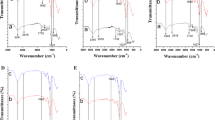Abstract
This study prepared nanocellulose from cassava residues by the mechanochemical method which adopted phosphoric acid as aids and used high-speed dispersion to offer mechanical force, aiming to improve the properties of such biodegradable materials as PLA, PHA and PVA and make full use of cassava residues. Stearic acid is used to improve the dispersity of the prepared nanocellulose, so that it can be well dispersed into some biodegradable materials with small polarity. In addition, these materials may also be hydrophobic after the addition of the modified nanocellulose. Nano Particle Analyzer, SEM and FTIR were applied to characterize the properties of the nanocellulose and the modified nanocellulose, and the dispersity of modified nanocellulose was characterized by the dispersity test. The results show that the size of the nanocellulose is between 15.1 and 18.1 nm, and there are a lot of small holes on its surface that leads to the increase of specific surface area. This modified method belongs to that of surface modification which can reduce the surface polarity of the nanocellulose and make it dispersed into the polar solvents.
Access this chapter
Tax calculation will be finalised at checkout
Purchases are for personal use only
Similar content being viewed by others
References
Klemm, D., Heublein, B., Fink, H. P., et al. (2005). Cellulose: Fascinating biopolymer and sustainable raw material. Angewandte Chemie International Edition, 544(22), 3358–3393.
Li, J. (2014). Hydrophobic modification of nanocellulose and its application in pulp and papermaking. Jinan: Qilu University of Technology.
Cao, G. (2004). Nanostructures & nanomaterials: Synthesis, properties & applications. Imperial College Press.
Dufresne, A. (2013). Nanocellulose: A new ageless bionanomaterial. Materials Today, 16(6), 220–227.
Salas, C., Nypelö, T., Rodriguez-Abreu, C., et al. (2014). Nanocellulose properties and applications in colloids and interfaces. Current Opinion in Colloid & Interface Science, 19(5), 383–396.
Tao, Z. (2012). Synthesis, characterization, retention and aiding properties of functional derivatives of Cassava residue. Guangzhou: South China University of Technology.
Cao, K., Wu Y., et al. (2016). Preparation and characterization of stearic acid modified nanofibrillated cellulose. Technological Innovation and Application, 28, 32–33.
Xiong, L., & Yu, W. (2013). Microscopic infrared spectroscopic analysis of cellulose molecular structure after acid treatment. Cellulose Science and Technology, 02, 59–62.
Fan, H., Wang, X., & Wang, Y. (2014). Rapid determination of wood cellulose content by Fourier Transform infrared spectroscopy. Wood Processing Machinery, 04, 33–37.
Liu, Y., Shao, G., & Xu, T. (2010). Infrared spectra analysis and comparison of bamboo fiber and other natural cellulose fibers. Bamboo Research Journal, 03, 42–46.
Acknowledgements
Thanks for the support given to this work by the Science and Technology Project of Guangdong Province (No. 2017B090901064), the Science and Technology Project of Guangzhou (No. 201607020045) and the Fundamental Research Funds for the Central Universities (Nos. D2154620).
Author information
Authors and Affiliations
Corresponding author
Editor information
Editors and Affiliations
Rights and permissions
Copyright information
© 2019 Springer Nature Singapore Pte Ltd.
About this paper
Cite this paper
Shi, Y., Chen, G., Chen, Q., Huang, L. (2019). Nanocellulose Prepared from Cassava Residues by Mechanochemical Method and Its Hydrophobic Modification. In: Zhao, P., Ouyang, Y., Xu, M., Yang, L., Ren, Y. (eds) Advances in Graphic Communication, Printing and Packaging. Lecture Notes in Electrical Engineering, vol 543. Springer, Singapore. https://doi.org/10.1007/978-981-13-3663-8_118
Download citation
DOI: https://doi.org/10.1007/978-981-13-3663-8_118
Published:
Publisher Name: Springer, Singapore
Print ISBN: 978-981-13-3662-1
Online ISBN: 978-981-13-3663-8
eBook Packages: EngineeringEngineering (R0)




